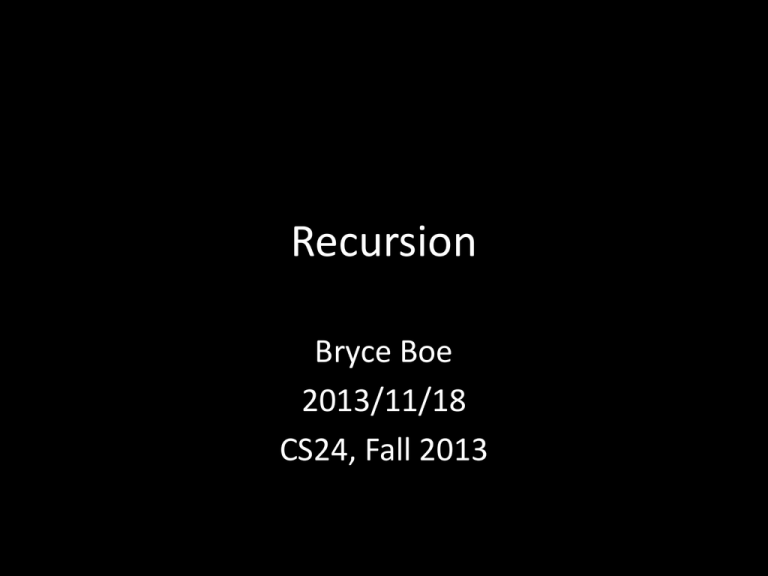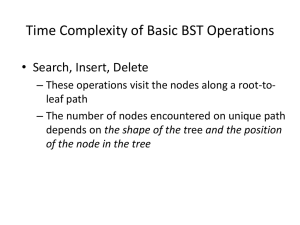pptx
advertisement

Recursion
Bryce Boe
2013/11/18
CS24, Fall 2013
Outline
•
•
•
•
•
•
•
Wednesday Recap
Lab 7 Iterative Solution
Recursion
Binary Tree Traversals
Lab 7 Recursive Solution
Merge Sort
BST Remove
WEDNESDAY RECAP
What is the depth of G?
3
What is the height of B?
1
What is the height of the tree?
3
Is the tree balanced?
No
LAB 7 SOLUTION
RECURSION
What is recursion?
• The process of solving a problem by dividing it
into similar subproblems
• Examples
– Factorial: 5! = 5 * 4! = 5 * 4 * 3!
– Length of linked list: L(node) = 1 + L(node->next)
– Fibonacci Numbers: F(N) = F(n-1) + F(n-2)
Factorial
• Base Case:
– F(1) = 1
• General Case
– F(n) = n * F(n-1)
Factorial
int factorial(n) {
if (n < 1) throw 1; // Error condition
else if (n == 1) // Base Case
return 1;
else // General Case
return n * factorial(n – 1);
}
Linked List Length
• Base Case:
– Length(last node) = 1
• General Case:
– Length(node) = 1 + Length(node->next);
Linked List Length (option 1)
int length(Node *n) {
if (n == NULL) // Base Case
return 0;
else // General Case
return 1 + length(n->next);
}
Linked List Length (option 2)
int length(Node *n) {
if (n == NULL) throw 1; // Error condition
else if (n->next == NULL) // Base Case
return 1;
else // General Case
return 1 + length(n->next);
Whatmuch
is thespace
size ofisthe
simplified
How
required
for aactivation
list with 8
}
record?
items?
Fibonacci Numbers
• Base Cases:
– F(0) = 0
– F(1) = 1
• General Case:
– F(n) = F(n-1) + F(n-2)
Recursion and the Stack Segment
• main calls Factorial(3)
main
Factorial(3)
Factorial(2)
Factorial(1)
Recursion question
• How many activation records are created
when calling Fibonacci(0)?
1
• Fibonacci(1)?
1
• Fibonacci(2)?
3
• Fibonacci(3)?
5
• Fibonacci(4)?
9
• Fibonacci(5)?
15
BINARY TREE TRAVERSALS
Depth-First Tree Traversals
• Can be done iteratively (with a stack) or
recursively
• Pre-order
– Process the node, recurse on left subtree, recurse on
right subtree
• In-order
– Recurse on the left subtree, process the node, recurse
on the right subtree
• Post-order
– Recurse on the left subtree, recurse on the right
subtree, process the node
Pre-Order Traversal
A -> B - > D -> E -> C -> F -> G -> H
In-Order Traversal
D -> B -> E -> A -> C -> G -> F -> H
Post-Order Traversal
D -> E -> B -> G -> H -> F -> C -> A
Breadth-first Traversal
• Cannot be done recursively
• Done iteratively with the help of a queue
– You did this in lab 7
Breadth-first (queue lhs before rhs)
A -> B -> C -> D -> E -> F -> G -> H
Question
• Which of the traversals will output a sorted
version of a binary search tree?
• When should you use recursion / iteration?
– Most importantly: use what you’re comfortable with
– With recursion be careful of stack depth (O(log(n))
memory is okay, O(n) is probably not)
• CHALLENGE:
– Implement the three depth-first traversals iteratively
LAB 7 RECURSIVE SOLUTION
Lab 7 Recursive ~BST
template <class T>
void bst_destruct(BinaryNode<T> *node) {
if (node != NULL) {
bst_destruct(node->get_rhs());
bst_destruct(node->get_lhs());
delete node;
}
What traversal order is this?
}
template <class T>
BST<T>::~BST() {
bst_destruct(root);
}
How much memory is
required?
Lab 7 Recursive insert
template <class T>
bool BST<T>::insert(T item) {
try {
root = bst_insert(root, item);
return true;
}
catch (int e) {
return false;
}
}
Lab 7 Recursive insert
template <class T>
BinaryNode<T> *bst_insert(BinaryNode<T> *node, T item) {
if (node == NULL)
return new BinaryNode<T>(item, NULL, NULL);
else if (item == node->get_data())
throw 1;
else if (item < node->get_data())
node->set_lhs(bst_insert(node->get_lhs(), item));
else
node->set_rhs(bst_insert(node->get_rhs(), item));
return node;
How much memory is
}
required?
Save space by using const references
where appropriate
template <class T>
BinaryNode<T> *bst_insert(BinaryNode<T> *node, const T &item) {
if (node == NULL)
return new BinaryNode<T>(item, NULL, NULL);
else if (item == node->get_data())
throw 1;
else if (item < node->get_data())
node->set_lhs(bst_insert(node->get_lhs(), item));
else
node->set_rhs(bst_insert(node->get_rhs(), item));
return node;
}
MERGE SORT
O(nlog(n)) Sort Algorithms
• Merge Sort
– Divide the problem in half until you have 1 or 2
items and put them in order
– Merge the two sorted halves
• T(n) = 2T(n/2) + O(n) === O(n*log(n))
– (masters theorem)
Coding Hint
• What’s wrong with the following?
int *tmp = new int[10];
tmp = some_function();
results in a memory leak
BST REMOVAL
Recall
• A binary search tree is a tree with the
property that the value of all descendants of a
node’s left subtree are smaller, and the value
of all descendants of a node’s right subtree
are larger
BST Example
BST Remove
• If the node has no children simply remove it
• If the node has a single child, update its
parent pointer to point to its child and remove
the node
Removing a node with two children
• Replace the value of the node with the largest
value in its left-subtree (right-most
descendant on the left hand side)
– Note you could use the smallest value in the rightsubtree (but for consistency please don’t)
• Then repeat the remove procedure to remove
the node whose value was used in the
replacement
Removing a node with two children









